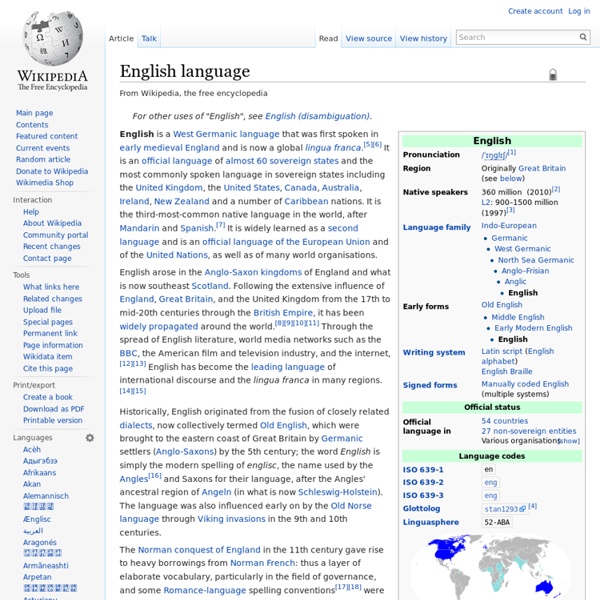Italian language
Italian ( italiano or lingua italiana) is a Romance language spoken mainly in Europe: Italy, Switzerland, San Marino, Vatican City, as a second language in Malta, Slovenia and Croatia, by minorities in Eritrea, France, Libya, Monaco, Montenegro, and Somalia,[5][dubious ] and by expatriate communities in the Americas and Australia. Many speakers are native bilinguals of both standardised Italian and other regional languages.[6]
Prepositions: Locators in Time and Place
A preposition describes a relationship between other words in a sentence. In itself, a word like "in" or "after" is rather meaningless and hard to define in mere words. For instance, when you do try to define a preposition like "in" or "between" or "on," you invariably use your hands to show how something is situated in relationship to something else. Prepositions are nearly always combined with other words in structures called prepositional phrases. Prepositional phrases can be made up of a million different words, but they tend to be built the same: a preposition followed by a determiner and an adjective or two, followed by a pronoun or noun (called the object of the preposition). This whole phrase, in turn, takes on a modifying role, acting as an adjective or an adverb, locating something in time and space, modifying a noun, or telling when or where or under what conditions something happened.
English people
The English are a nation and ethnic group native to England, who speak the English language. The English identity is of early mediaeval origin, when they were known in Old English as the Angelcynn. England is one of the countries of the United Kingdom and English people in England are British citizens. Their ethnonym is derived from the Angles, Germanic peoples who migrated to Great Britain in the fifth century AD.[8] Today some English people have recent forebears from other parts of the United Kingdom while some are also descended from more recent immigrants from other European countries and from the Commonwealth. The English people are the source of the English language, the Westminster system, the common law system, and numerous major sports.
English Grammar: a complete guide
Do you have a question about the correct usage of the semicolon or how to place adverbs in a sentence? If so, you've come to the right place. Edufind.com is a complete English grammar guide filled with the rules of English usage.
French language
French (le français [lə fʁ̥ɒ̃sɛ] ( ) or la langue française [la lɑ̃ɡ fʁɑ̃sɛz]) is a Romance language spoken as a first language in France, the Romandy region in Switzerland, Wallonia and Brussels in Belgium, Monaco, the provinces of Quebec, Ontario and New Brunswick (Acadia region) in Canada also in Haiti, the Acadiana region of the U.S. state of Louisiana, the northern parts of the U.S. states of Maine, New Hampshire and Vermont in the New England region, and by various communities elsewhere. Other speakers of French, who often speak it as a second language,[3] are distributed throughout many parts of the world, the largest numbers of whom reside in Francophone Africa.[4] In Africa, French is most commonly spoken in Gabon (where 80% report fluency),[4] Mauritius (78%), Algeria (75%), Senegal and Côte d'Ivoire (70%). French is estimated as having 110 million[3] native speakers and 190 million more second language speakers.[5] Geographic distribution[edit]
Verb
Agreement In languages where the verb is inflected, it often agrees with its primary argument (the subject) in person, number, and/or gender. With the exception of the verb to be, English shows distinctive agreement only in the third person singular, present tense form of verbs, which are marked by adding "-s" ( walks) or "-es" (fishes). The rest of the persons are not distinguished in the verb (I walk, you walk, they walk, etc.).
Home : Oxford English Dictionary
Goidelic languages
The Goidelic or Gaelic languages (Irish: teangacha Gaelacha, Scottish Gaelic: cànanan Goidhealach, Manx: çhengaghyn Gaelgagh) are one of the two branches of the Insular Celtic languages, the other consisting of the Brittonic languages.[2] Goidelic languages historically formed a dialect continuum stretching from Ireland through the Isle of Man to Scotland. There are three modern Goidelic languages: Irish (Gaeilge), Scottish Gaelic (Gàidhlig) and Manx (Gaelg), the last of which died out in the 20th century, but has since been revived to some degree.[3] The Goidelic languages are part of the Q-Celtic branch of the Celtic languages.
BBC Learning English - Learning English
Language
A mural in Teotihuacan, Mexico (c. 2nd century) depicting a person emitting a speech scroll from his mouth, symbolizing speech Language is the human capacity for acquiring and using complex systems of communication, and a language is any specific example of such a system. The scientific study of language is called linguistics. Languages evolve and diversify over time, and the history of their evolution can be reconstructed by comparing modern languages to determine which traits their ancestral languages must have had in order for the later developmental stages to occur. A group of languages that descend from a common ancestor is known as a language family. Definitions[edit]
Old Norse
Old Norse is a North Germanic language that was spoken by inhabitants of Scandinavia and inhabitants of their overseas settlements during the Viking Age, until about 1300. The Proto-Norse language developed into Old Norse by the 8th century, and Old Norse began to develop into the modern North Germanic languages in the mid- to late 14th century, ending the language phase known as Old Norse. These dates, however, are not absolute, since written Old Norse is found well into the 15th century.[2] Old Norse was divided into three dialects: Old East Norse, Old West Norse, and Old Gutnish. Old West and East Norse formed a dialect continuum, with no clear geographical boundary between them. For example, Old East Norse traits were found in eastern Norway, although Old Norwegian is classified as Old West Norse, and Old West Norse traits were found in western Sweden.



